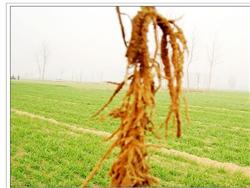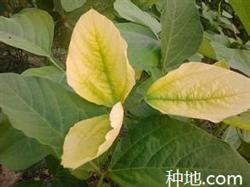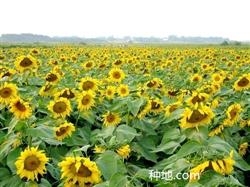What is soybean cyst nematode?

What is soybean cyst nematode disease? How to control soybean cyst nematode disease: (1) harm and symptoms soybean cyst nematode disease is also called verticillium wilt, commonly known as "fire dragon seedling". It is a worldwide disease of soybean. It occurs in large areas in major soybean producing countries: USA, Brazil, China and Japan. It mainly occurs in Northeast China, North China, Henan, Shandong and Anhui. Especially in the arid areas in the west of the three northeastern provinces, such as Kangping in Liaoning Province, Baicheng in Jilin Province, Zhaodong, Anda, Daqing, Qiqihar and other areas in Heilongjiang Province. Generally, soybean production is reduced by 10%-20%, serious production is reduced by 70%-90%, or even no production. Soybean cyst nematode mainly damages roots, damaged plants are stunted and short. The cotyledons and true leaves became yellow after infection at seedling stage, and the growth was delayed; the plants infected with the disease were dwarfed and withered, with few or no pods, and the whole plant died seriously. The root system of diseased plants is underdeveloped, lateral roots are significantly reduced, fine roots are increased, and nodules are rare. In the early stage of the disease (from late June to early July in Heilongjiang Province), many white or yellow brown particles were observed on the roots, that is, female adults of cyst nematode, which is an important feature to identify cyst nematode disease. Cyst nematodes overwinter in soil with eggs in cysts, which have strong resistance to adverse environment. The second instar larvae invade from the root hairs of the host young roots in the spring of the next year and develop into adults in the cortex of the soybean young roots. The female body gradually becomes lemon-like with the formation of internal eggs, breaks through the surface layer and exposes the host body. It only adheres to the host roots with its mouthparts. This is the white small particles on the soybean roots we see. Soybean cyst nematode can be divided into different physiological races due to different pathogenicity. Race 1, 2, 3, 4, 5 and 7 have been identified in China. Race 1 was mainly distributed in Liaoning, Jilin, Shandong Weifang, Jiaodong Peninsula and Jiangsu provinces; race 2 was mainly distributed in Liaocheng and Dezhou of Shandong Province; race 3 was mainly distributed in Heilongjiang, Jilin and Liaoning provinces. Race 4 was mainly distributed in Shanxi, Henan, Jiangsu, Shandong, Anhui, Hebei and Beijing, race 5 in Jilin, Anhui and Inner Mongolia, race 7 in Shandong and Henan. (2) Control soybean cyst nematode is a soil-borne disease which is very difficult to control because of its wide distribution, heavy damage, wide host range, many transmission routes and long survival time. The application of resistant varieties is an economic and effective measure to control soybean cyst nematode disease. More than one hundred resistant varieties have been bred in America and Japan, which have been widely popularized and applied in production with obvious yield increase effect. Since 1992, resistant varieties such as Kangxian 1, 2, 3, Nenfeng 15 and Qingfeng 1 have been popularized successively in our province, and the yield increase effect is obvious in western nematode areas of our province. However, with the extension of resistant varieties, the physiological races of soybean cyst nematode may change due to the pushing force of variety selection. in recent years we the soybean institute of Heilongjiang Province academy of agricultural science monitor that physiological race of soybean cyst nematode in Anda and Daqing areas. the result showed that besides race 3, new race 1, 4, 6 and 14 appeared, which indicated that the races of soybean cyst nematode had changed after continuous planting of resistant varieties. therefore, the resistant varieties should be planted alternately with host crops other than soybean cyst nematode or other resistant varieties in production In order to slow down the physiological race variation speed, prevent the disease-resistant varieties from losing disease resistance, and prolong the application life of disease-resistant varieties. In the absence of disease resistant varieties should be used for more than 3 years of rotation and chemical control methods, can use 3% carbofuran granules or 5% aldicarb granules, 4-5 kg per mu, applied to the sowing ditch, and then sowing. Click to see more soybean planting technology Click to see more food crop planting technology
- Prev

What is soybean yellowing and how to prevent it?
What is soybean yellowing and how to prevent it? There are several main reasons for soybean yellowing: first, soybean cyst nematode disease. The disease is mainly distributed in soybean continuous cropping plots for many years and areas with low groundwater level. After the seedling stage illness, the leaf is yellowish brown, the growth is slow, serious when the whole plant withered; after the adult plant stage illness,.
- Next

How to control underground pests by planting sunflowers?
How to control underground pests when growing sunflowers? The main underground pests of sunflower are mole cricket, grub, ground tiger, golden needle worm and other underground pests. The control measures are as follows. (1) Agricultural prevention and control. ① uprooted weeds in the field and buried or transported weeds in time before sunflower emergence or during the peak period of 1st and 2nd instar larvae.
Related
- The first cup of black tea in spring, the flavor and history of tea gardens in Kenya, Africa
- The computer can not only choose potatoes, but also grow tea rice. AI will grow winter oolong tea champion.
- It is not only the inflated tea bitten by insects, but also engraved with the four seasons tea in Beipu.
- The Oriental Beauty Tea Festival in Zhuxian County takes the stage at the weekend to experience the plus-size feast of oil tea.
- & quot; Oriental Beauty Tea & Exploration of Emei in Hsinchu, the hometown of quot;
- The new variety of strawberry "Tainong 1" dessert is the first choice with mellow aroma. Crimson gorgeous
- History of Tea in Taiwan: from Wild Inner Mountain to Export Tea Garden
- Two types of Taiwan Oriental Beauty Black Tea won the British three-Star Award for Childhood Tea Xiang Zhang Jiaqi changed from pilot to champion tea maker.
- Banana species and varieties: the planting history of Taiwan Xianren banana and dwarf banana is long, is banana disease resistant?
- Coffee planting Technology: Qianjie Coffee from Seedling to harvesting

